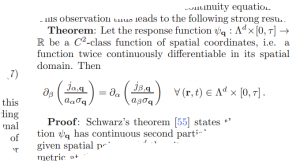N. Tizón-Escamilla, P.I. Hurtado and P.L. Garrido
Macroscopic fluctuations have become an essential tool to understand physics far from equilibrium due to the link between their statistics and nonequilibrium ensembles. The optimal path leading to a fluctuation encodes key information on this problem, shedding light on e.g. the reasons behind the enhanced probability of rare events out of equilibrium, the possibility of dynamic phase transitions and new symmetries. This makes the understanding of the properties of these optimal paths a central issue. Here we derive a fundamental relation which strongly constraints the architecture of these optimal paths for general d-dimensional nonequilibrium diffusive systems, and implies a non-trivial structure for the dominant current vector fields. Interestingly, this general relation (which encompasses and explains previous results) makes manifest the spatio-temporal non-locality of the current statistics and the associated optimal trajectories.
equilibrium due to the link between their statistics and nonequilibrium ensembles. The optimal path leading to a fluctuation encodes key information on this problem, shedding light on e.g. the reasons behind the enhanced probability of rare events out of equilibrium, the possibility of dynamic phase transitions and new symmetries. This makes the understanding of the properties of these optimal paths a central issue. Here we derive a fundamental relation which strongly constraints the architecture of these optimal paths for general d-dimensional nonequilibrium diffusive systems, and implies a non-trivial structure for the dominant current vector fields. Interestingly, this general relation (which encompasses and explains previous results) makes manifest the spatio-temporal non-locality of the current statistics and the associated optimal trajectories.
